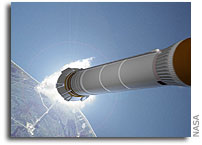First Stage Design Problems Arise For NASA’s Ares 1 Rocket

NASA has run into some problems with the design of its new Ares 1 launch vehicle – problems that could affect its ability (as designed) to safely launch its human cargo into space.
The Ares 1 and the Orion capsule (also under development) are designed to replace the crew carrying function of the current Space Shuttle fleet which is due to be retired in 2010. The first flight of humans aboard an Ares 1 is planned for March 2015.
According to NASA sources, the Ares 1 first stage, as currently designed, would produce a frequency of 25 Hz at liftoff. The concern is that this oscillation could shake the Ares 1 upper stage and Orion capsule designed to carry human passengers, causing considerable damage and that it could also adversely affect the Guidance, Navigation, and Control avionics in the rocket’s Instrumentation Unit.
When asked to comment on this development, NASA’s Exploration System Mission Directorate (ESMD) Public Affairs Officer replied:
“The Ares Project Office identified Ares I thrust oscillation as a potential integrated stack challenge as a part of its system definition review which concluded in October. Thrust oscillation or resonant burning is a characteristic of all solid rocket motors. It is caused by vortex shedding inside the solid rocket motor, similar to the wake that follows a fast-moving boat. When the vortex shedding coincides with the acoustic modes of the motor combustion chamber, pressure oscillations generate longitudinal forces that may affect the loads experienced by the Ares I during the last phase of first-stage flight. NASA is assessing the analyses in more detail, looking for any potential impacts to the integrated stack and ways to mitigate those impacts. Results are due in spring 2008. It is a normal part of the development process to identify, mitigate and track challenges such as this.”
NASA sources also report that the 6 month slip in the Ares 1 PDR (Preliminary Design Review) recently announced could impact the first launch of humans aboard an Ares 1 by as much as 14-16 months beyond the publicly announced first flight date of March 2015.
NASA ESMD’s response: “NASA decided to move the Ares I first stage preliminary design review to summer 2008 to allow better alignment with current Ares Project and Constellation Program preliminary design review planning. Conducting the first stage preliminary design review in summer 2008 will not cause NASA to delay the target date for the first flight with humans.”
In addition, NASA sources report that the option of having a non-recoverable first stage for Ares 1 is also still under active consideration within the Ares design team – this despite stern statements to the contrary by former ESMD head Scott Horowitz last year.
NASA’s response: “NASA is not considering a non-recoverable first stage for Ares I. A recoverable system is the preferred approach, and the agency confirmed this baseline through a trade study as part of the recent systems definition review.”








